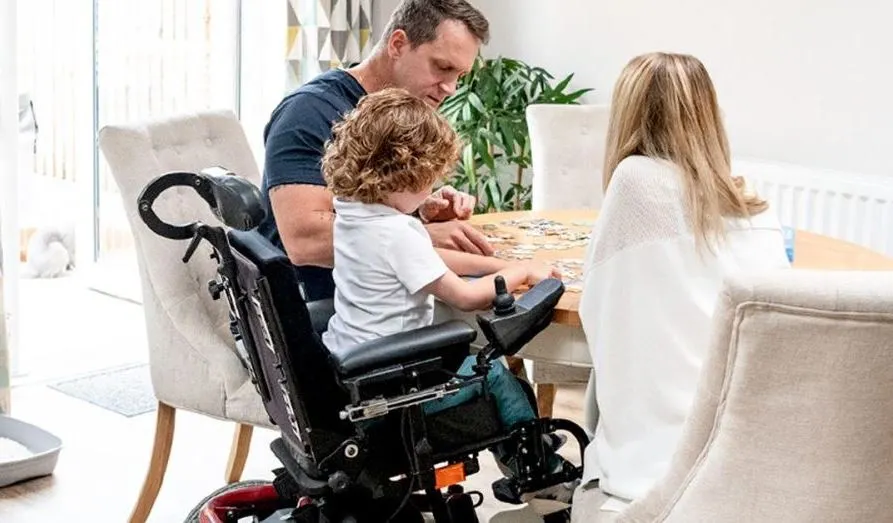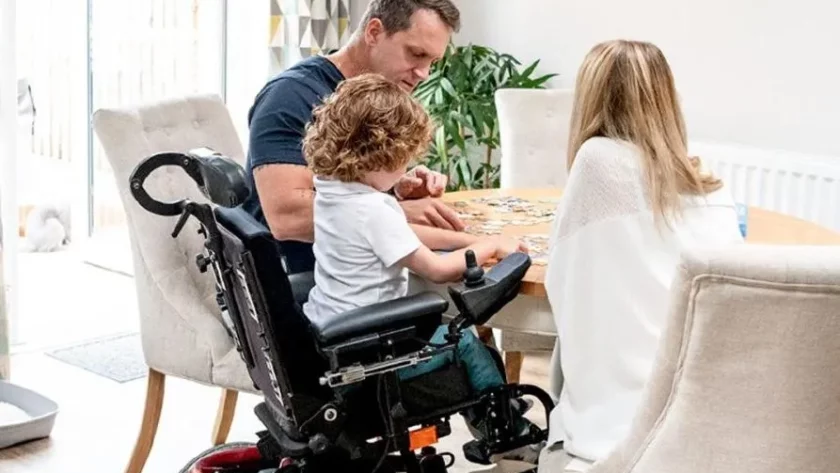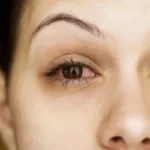What is SMA?
Contents
Spinal muscular atrophy (SMA) is a hereditary disease means – it’s transferred from one generation to another generation.
It mostly affects infants, In this children cannot control their movements due to this, it becomes difficult for children to walk, sit, breathe, and swallow.
It is a group of hereditary diseases, which destroy motor neuron nerve cells of the brain, stem, and spinal cord.
But what are motor neuron nerve cells? – These nerves control our body’s Skeletal Muscle Activities like:
- Speaking
- walking
- swallowing, and breathing
But when it is destroyed in the brain and spinal cord, then it is not able to do its function properly, due to which the muscle becomes weak.
This motor neuron is very important to control arms, legs, throat, face, tongue, and chest movement.
How common is it?
Spinal muscular atrophy (SMA) is a rare genetic disorder, which commonly affects children, and affects the brain and spinal cord.
This disease affects only one in 8 to 10,000 children. It may also appear later in life and then have a milder course of the disease.
This disease can affect more than 1 person of the same generation.
In very rare cases, it also happens that without hereditary this disease occurs, which causes is a mutation in genes.

Why does it affect the children even after the parents are fine?
As we know genes play an important role in this disease, but parents are totally fine, still seen in children why?
This disease often passes from one generation to another through an autosomal recessive pattern.
Means – The person who has SMA gets two mutated genes, one from the father and the other from the mother.
And the person who gets the gene from the same parents, are carriers of this disease.
Meaning – they do not see any symptoms of SMA, but they can transfer this disease to the next generation.
Types
Spinal muscular atrophy (SMA) is classified into 4 types, some show up earlier and are more severe than others.
And it’s symptoms depend on what type of SMA is included:
Type 1
This type is also called infantile-onset SMA or werdnig-Hoffmann disease.
This type most often occurs in babies under 6 months of age and is more likely to die in their first year. And a child may be born with breathing issues.
Its symptoms are something like this:
- Reduce muscle movement
- Shortness in breath
- Very slow limb movement
- Curvature of the spinal cord
- Skeletal abnormalities
Most children with type 1 SMA don’t live more than age 2 because of respiratory problems.
Type 2
This is known as the intermediate form. Symptoms of this type appear between about 6 to 18 months
Patients are able to maintain a sitting position at least some time in their life but never learn to walk unsupported.
They may also occur breathing problems. And due to the change in this treatment, the children are now able to walk and sit properly.
Type 3
This is also known as Kugelberg–Welander disease. Its symptoms are visible after 18 months of age.
Such children can walk on their own. but in the beginning, they face problems in activities like:
- Running
- climbing stairs
- walking
- getting up from the chair
With the right kind of treatment and better health facilities, such children can lead a normal life. Thanks to science.
Type 4
This 4th type whose symptoms appear after 21 years of age, In this mild to moderate symptoms of muscle weakness, are seen.
Commonly seen symptoms such as:
- Muscle weakness
- Twitching, or breathing problems
Usually, only your upper arms and legs are affected.
You may have symptoms for the rest of your life, but you can move on. Also, exercise can help a lot, you will practice this with the help of a doctor.
Reasons Behind the SMA
SMA is mainly caused by a gene called SMN 1 gene. This gene does not make enough protein for the motor neurons to work properly.
And without MNNC (Motor neurons nerve cells) that control muscles die.
NOTE: If your children get a faulty gene from one of your, they will not get SMA, but they will be a carrier of the disease.
Means – They could pass the broken gene to their own child. this will increase the risk of SMA disorder in his child.
One in 40-60 adults has a genetic problem that can cause spinal muscular atrophy (SMA).
People also have SMN2 genes, which produce a small amount of SMN protein. And a person may have up to 8 copies of an SMN2 gene.
Having SMN2 multiple copies of the gene typically leads to less severe SMA symptoms because the extra genes make up for the missing SMN1 protein.
Symptoms
Symptoms usually appear a few months after birth in people with SMA, but these symptoms also appear later in life.
The most common symptoms of SMA in all types are:
- Muscle weakness, usually worsens with age
- difficulty in breathing and swallow
- In small children – frog leg position while sitting
- Change in spinal cord, chest, limbs due to weak muscles
- weak cough, and cry (infants)
- difficulty in speaking, and walking
- Twitching of the tongue
In many cases, curb shape also comes in the spine.
SMA type 1 is most commonly seen, and muscle weakness is the most common symptom.
These occur because the motor neurons nerve cells are unable to give the muscle the signal to contract.
Diagnose

A doctor will ask about medical history or family history.
If this disease is in children, then its doubt can go in late pregnancy.
In which the child is completely inactive. and after the birth of the child, they are not able to feed properly or less movement.
And from there, the doctor may be in doubt, due to which the doctor may ask to get these tests done. which include:
- Blood test
- Genetic testing
- Muscle biopsy
- Nerve condustion test
- Chorionic villus sampling can allow the doctor to evaluate the fetus in the womb.
Treatments
There is no total cure for spinal muscular atrophy (SMA), but there are 3 medicines that have been approved for SMA. which include:
But First why its treatment is so expansive?
The dose of the vaccine in its treatment is around Rs 16 Crore, in India, which is quite expensive.
This drug (zolgensma) is commercially available in the US.
This is what makes its cost so high because it is imported to India with a GST which makes it the most expensive.
And also due to the things used while making this injection, its cost increases significantly.
Zolgensma
The drug is essentially a one-time gene replacement and was approved to treat only children under age 2 years old with SMA in 2019.
Basically, it replaces the function of the non-functional or the non-working SMU with the new one.
- Single dose therapy
- cost about 16 crore
When patients take a shot of this vaccine, then a virus called AAV9 enters its body.
which takes place defective SMN1 gene, that increases SMN protein level, which improves motor neuron function and improves symptoms.
Spinraza
This drug is used for both children and adults with SMA. A doctor will inject 4 initial doses over about 2 months, After that give a maintenance dose every 4 months.
A single dose of Spinraza injection costs Rs 87 lakh in India. 7 doses are given in the first year of the treatment, followed by three doses every year for the rest of the patient’s life.
It’s slow the progression of SMA, and it may reduce muscle weakness, but its effectiveness might vary between individuals.
RIsdiplam
Recently a new medicine has arrived in 2020, which was approved by the food and drug administration, it is available in tablet form.
Which cost is also high, around 6 lakh per bottle, and a child needs 6 bottles in 1 year.
Evrysdi
This treatment prevented the SMN2 gene from inhibiting protein production that helps the protein reach the nerve cells are needed.
It was approved by FDA in 2020, its dosage is determined by children’s weight.
Some other treatments to manage symptoms
- Breathing support by breathing machine
- Swallowing and nutrition – In this doctor may suggest babies a feeding tube
- Movement – physical therapy or exercise can help patients to move joints, to keep them strong. A therpist can suggest a walker, or weelchair.
- Curv spine – A doctor can be wearing a child’s back brace, while their spine is still growing. When the spine stopped growing, they may have surgery to fix the problem.
Compications
Over growing age, people with SMA may experience more muscle weakens difficulty in walking, loss of control, and other complications.
- Bone feature, this type of person is more prone to fracture.
- dehydration
- lack of nutrition due to problem in swallowing food
- Pneumonia, and other lungs infection
- Breathing problems, due to weak lungs, In this patient may require a breathing machine.
BOTTOM LINE
It mostly affects infants, In this children cannot control their movements due to this, it becomes difficult for children to walk, sit, breathe, and swallow.
This disease affects only one in 8 to 10,000 children. It may also appear later in life.
SMA is mainly caused by a gene called SMN 1 gene. This gene does not make enough protein for the motor neurons to work properly.




